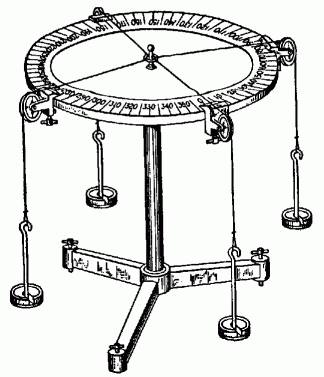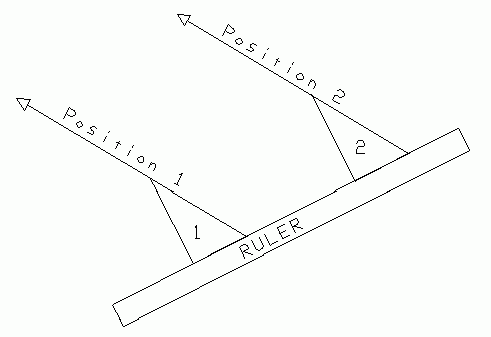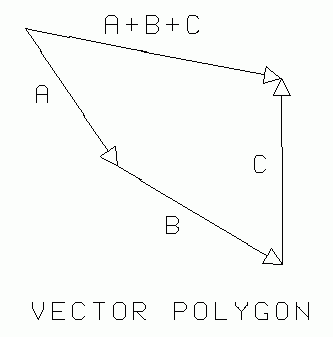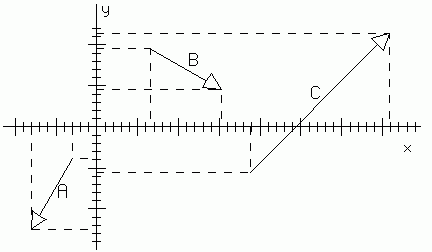S-1 VECTOR ADDITION OF FORCES
1. PURPOSE:
(1) Study static equilibrium under the action of several concurrentforces.
(2) Test whether the forces on a body at rest add to zero.
(3) Study how errors in vectors propagate.
2. APPARATUS:
Force table, three weight hangers, metric weight set, 17 x 11 or 17 x 22" drawing paper.
3. BACKGROUND:
Read the chapters on vectors and components of vectors in any physics textbook.
4. NOTE ON UNITS:
You can avoid unnecessary multiplications by 9.8 m/s2 or 980 cm/s2 by expressing all weights in grams. This "convenience unit" is sometimes called the "gram-weight."
5. THEORY:
Forces. Many measurable quantities in physics obey the laws of vector algebra, and force is one example. The vector sum of the forces on a body is important because it determines whether the body will move, and how it will move.
In this experiment you will study the special case of a body at rest under the action of only three forces.
Static Equilibrium describes the condition in which a body is at rest with respect to a frame of reference. When a body is in static equilibrium:
(1) The vector polygon of all forces acting on the body in static equilibrium is closed. The sum of the vectors representing the forces is zero.
(2) The sum of the components of force along any axis is zero.
6. GENERAL INSTRUCTIONS:
Read this section before beginning section 7, Procedure.
 |
| Fig. 1. Force table. |
|---|
The force table apparatus demonstrates the addition of forces acting on a body, in two dimensions. In this experiment the force table is a disk with pulleys attached at its edges. Strings attach to a ring at the center, pass over the pulleys to weight hangers.
Take care to adjust the pulleys so the strings pass straight over them, ensuring minimum friction. Use enough weight on the hangers so the strings are nearly parallel to the table and do not sag much. Why is this important?
Important:The force exerted by a string on the ring is the sum of the weight on the hanger plus the weight of the hanger. The hanger's mass is usually marked on the hanger, but it's a good idea to check that by weighting them yourself.
When you achieve equilibrium of the body, the directions of the forces lie along the direction of the strings. In each situation, adjust the weights and angles so that the ring is centered on the table, and is not touching the center post. Record the amount of weight on each hanger, and read the direction of its string on the table's scale.
Errors in vectors. One source of error in this experiment is the starting friction in the pulleys. The size of this error is estimated by determining how much the weight on a weight hanger can be varied without disturbing the equilibrium. Do this, and find the full range of the uncertainty in each force. The "best" value of this force is at the center of this range. Record the uncertainty of the force and its percent uncertainty. Investigate and record the error in the angle in the same way.
7. SITUATIONS TO INVESTIGATE:
Each different situation may be recorded on a separate sheet of drawing paper. The analysis for each situation is then done directly on that work sheet.
Use 200 to 500 gram weights on the hangers. Avoid situations where all hangers have the same weight. Try for a representative, general case. Avoid special situations such as 30°, 45°, or 90° between the forces.
(1) THREE FORCES. Set up an equilibrium situation with three forces acting on the ring. Transfer the forces to the paper.
8. ANALYSIS:
 |
| Fig. 2. Moving a line parallel to itself with ruler and triangle. |
|---|
(1) POLYGON METHOD. When adding vectors by the polygon method you must "move" the vectors parallel to themselves. This is easily done with ruler and triangle as shown in Fig. 2. Lay an edge of the triangle along the vector, then lay a ruler along another edge of the triangle. Hold the ruler firmly in place on the paper and slide the triangle along the ruler until its edge falls where you want the vector relocated. Draw the line of action of this vector along the edge of the triangle.
Fig. 3. illustrates the addition of three vectors by the polygon method. The vectors may be assembled into the polygon in any order, since vector addition is commutative. In the case of static equilibrium, which you are investigating, the vectors will very likely add to nearly zero, so that any resultant A+B+C will be very small relative to the vectors being added.
 |
 |
| Fig. 3. Polygon method for adding forces. | |
|---|---|
On a clear area of your work sheet, transfer the forces onto a vector polygon and test whether the polygon closes. It probably won't close perfectly. Why not? What is the size and direction of the additional "error" vector required to close the polygon? Is its size consistent with the error caused by error in each of the individual forces? This last question will require considerable analysis, and a consideration of how to do an error propagation calculation for vectors. Carry out this analysis for both experimental situations.
(2) ANALYTIC METHOD. For each situation, choose arbitrary X and Y axes, and resolve the vectors into components along these axes. It is not necessary to move the original vectors on the sheet. Merely drop construction lines (dotted lines in Fig. 5) from their heads and tails, perpendicular to the chosen axis. Measure the sizes of the components and record these in tabular form. Numerically add the X and Y components separately to obtain the X and Y components of the resultant. Is the resultant zero? If not, is its size consistent with the resultant found in analysis step (2)? Estimate how much additional error is introduced into the drawing by construction and measurement steps.
 |
| Fig. 4. Components of vectors by the analytic method. |
|---|
Example: Refer to Fig. 6. Find the components of vector B. Its head is at coordinate (16.2,4.7) and its tail is at (6.5,9.8). Its x component is therefore 16.2 - 6.5 = 9.7, and its y component is 4.7 - 9.8 = -5.1. Notice how the y component came out negative. The vector is pointing "downward" (negative) with respect to the y axis, but "forward" (positive) with respect to the x axis.
Exercise 1. Refer to Fig. 6. (a) Find the components of vector A. (b) Find the components of A+B. (c) Find the components of vector C. (d) Find the components of A+B+C.
Good "bookkeeping" is essential when doing these problems. For example, the following table keeps track of the numbers of exercise 1. We have only filled in part of it: you may fill in the rest.
 |
| Fig. 5. Good bookkeeping. |
|---|
The size (magnitude) of a vector is always positive, and may be found by using the Pythagorean theorem if the components are known. The angle of a vector is conveniently specified with respect to the positive x axis, measured counterclockwise. If the components are known, the angle is arctan(Vy/Vx).
Note that your electronic calculator always returns an angle less than 90°, which you must convert to correctly indicate the quadrant in which the angle lies. Obviously the calculator cannot do more for you because of the ambiguity of sign: Vy/Vx has the same sign (positive) in first and third quadrants, and in the second and fourth quadrants the sign is negative.
9. QUESTIONS:
(1) If the weights of the weight hangers were exactly the same could their weights have been neglected in the computations? Explain.
(2) One form of apparatus for this experiment has a special circular table with degree markings around its rim. Three forces are applied to strings attached to a small round metal ring around a center post. The center post keeps the ring centered while the system is being balanced. When balance is achieved the ring is centered on the post, but not touching the post. The post can then be removed. Was the ring in equilibrium during the time when the weights were being balanced, while the ring was still touching the post?
(3) Can one place three forces of 50, 75, and 150 grams at such angles that they will produce equilibrium? Explain your answer, and try to make a general statement about this situation.
(4) Where on earth can one travel 10 miles north, then 10 miles west, then 10 miles south and end up at the starting point? Why doesn't this seem to obey the laws of vector addition.
(5) One answer to question (6) was easy to find, but there are other answers. In fact, there are an unlimited number of other starting points on the surface of the earth from which this may be done, and they all have a special relation to each other. Make a general statement describing the location of these points.
(6) [Cioffari] The x and y cartesian components of a certain force are measured and found to be 68 ± 3 and 42 ± 2 N respectively. Calculate the direction and magnitude of this force, expressing your result to the proper number of significant figures and showing the error in both magnitude and angle. Note that the error in the latter is obtained from the error in its tangent. Devise a procedure for doing this and show your work.
Text and drawings ©: 1997, 2004 by Donald E. Simanek.